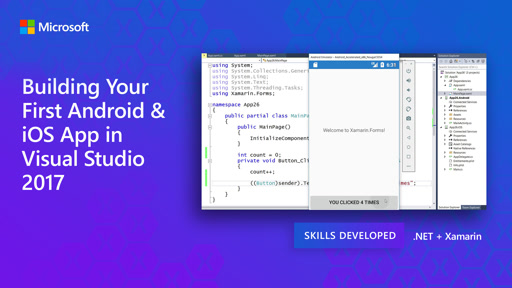By Daniel Roth, Steve Smith and Rick Anderson
This article will show you how to write your first ASP.NET Core application on a Mac.
Sections:
To setup your development machine download and install .NET Core and Visual Studio Code with the C# extension.


Do not move the XCode.app (or XCodeoldversion.app) after it has been launched fro the first time. Also if you have two versions of XCode installed, you may at times have to switch which version of the Xcode command line tools will be used, which can be done in XCode-Preferences-Locations tab. After developing chunk of your app within Visual Studio MAC, the best is to get the code on the windows machine and arrange it to work in UWP. UWP apps compile fastly and like a charm, so better is to get rid of errors within macOS, IOS, Android, and then go and adapt to UWP. Let's take a look at building your first iOS & Android app with.NET in Visual Studio 2017. We'll look at the app's structure, creating the UI, and adding so. The Mac is required for building as well as running the iOS simulator. You can either use it as a build server, and actually do your development in Visual Studio (either.
Follow the instruction in Building Projects with Yeoman to create an ASP.NET Core project.
- Start Visual Studio Code

- Tap File > Open and navigate to your Empty ASP.NET Core app
From a Terminal / bash prompt, run dotnetrestore to restore the project’s dependencies. Alternately, you can enter commandshiftp in Visual Studio Code and then type dot as shown:
How To Install Visual Studio On Mac
You can run commands directly from within Visual Studio Code, including dotnetrestore and any tools referenced in the project.json file, as well as custom tasks defined in .vscode/tasks.json.
This empty project template simply displays “Hello World!”. Open Startup.cs in Visual Studio Code to see how this is configured:
If this is your first time using Visual Studio Code (or just Code for short), note that it provides a very streamlined, fast, clean interface for quickly working with files, while still providing tooling to make writing code extremely productive.
In the left navigation bar, there are four icons, representing four viewlets:

- Explore
- Search
- Git
- Debug
The Explore viewlet allows you to quickly navigate within the folder system, as well as easily see the files you are currently working with. It displays a badge to indicate whether any files have unsaved changes, and new folders and files can easily be created (without having to open a separate dialog window). You can easily Save All from a menu option that appears on mouse over, as well.
Visual Studio For Mac Extensions
The Search viewlet allows you to quickly search within the folder structure, searching filenames as well as contents.
Code will integrate with Git if it is installed on your system. You can easily initialize a new repository, make commits, and push changes from the Git viewlet.
The Debug viewlet supports interactive debugging of applications.
Finally, Code’s editor has a ton of great features. You’ll notice unused using statements are underlined and can be removed automatically by using command. when the lightbulb icon appears. Classes and methods also display how many references there are in the project to them. If you’re coming from Visual Studio, Code includes many of the same keyboard shortcuts, such as commandkc to comment a block of code, and commandku to uncomment.
The sample is configured to use Kestrel for the web server. You can see it configured in the project.json file, where it is specified as a dependency.
- Run
dotnetruncommand to launch the app - Navigate to
localhost:5000:
- To stop the web server enter
Ctrl+C.
Once you’ve developed your application, you can easily use the Git integration built into Visual Studio Code to push updates to production, hosted on Microsoft Azure.
Initialize Git¶
Initialize Git in the folder you’re working in. Tap on the Git viewlet and click the InitializeGitrepository button.
Add a commit message and tap enter or tap the checkmark icon to commit the staged files.
Git is tracking changes, so if you make an update to a file, the Git viewlet will display the files that have changed since your last commit.
Initialize Azure Website¶
You can deploy to Azure Web Apps directly using Git.
- Create a new Web App in Azure. If you don’t have an Azure account, you can create a free trial.
- Configure the Web App in Azure to support continuous deployment using Git.
Record the Git URL for the Web App from the Azure portal:
In a Terminal window, add a remote named
azurewith the Git URL you noted previously.gitremoteaddazurehttps://ardalis-git@firstaspnetcoremac.scm.azurewebsites.net:443/firstaspnetcoremac.git
Push to master.
gitpushazuremasterto deploy.
Browse to the newly deployed web app. You should see
Helloworld!
